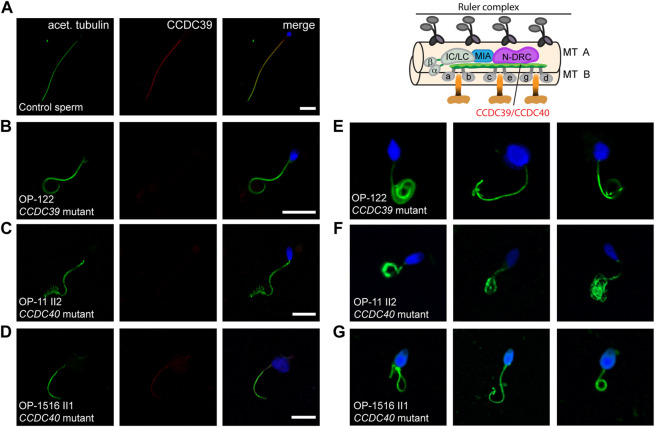Pathogenic gene variants in CCDC39, CCDC40, RSPH1, RSPH9, HYDIN, and SPEF2 cause defects of sperm flagella composition and male infertility
Aprea I, Wilken A, Krallmann C, Nöthe-Menchen T, Olbrich H, Loges NT, Dougherty GW, Bracht D, Brenker C, Kliesch S, Strünker T, Tüttelmann F, Raidt J, Omran H., 17.02.2023
Abstract
Primary Ciliary Dyskinesia (PCD) is a rare genetic disorder affecting the function of motile cilia in several organ systems. In PCD, male infertility is caused by defective sperm flagella composition or deficient motile cilia function in the efferent ducts of the male reproductive system. Different PCD-associated genes encoding axonemal components involved in the regulation of ciliary and flagellar beating are also reported to cause infertility due to multiple morphological abnormalities of the sperm flagella (MMAF). Here, we performed genetic testing by next generation sequencing techniques, PCD diagnostics including immunofluorescence-, transmission electron-, and high-speed video microscopy on sperm flagella and andrological work up including semen analyses. We identified ten infertile male individuals with pathogenic variants in CCDC39 (one) and CCDC40 (two) encoding ruler proteins, RSPH1 (two) and RSPH9 (one) encoding radial spoke head proteins, and HYDIN (two) and SPEF2 (two) encoding CP-associated proteins, respectively. We demonstrate for the first time that pathogenic variants in RSPH1 and RSPH9 cause male infertility due to sperm cell dysmotility and abnormal flagellar RSPH1 and RSPH9 composition. We also provide novel evidence for MMAF in HYDIN- and RSPH1-mutant individuals. We show absence or severe reduction of CCDC39 and SPEF2 in sperm flagella of CCDC39- and CCDC40-mutant individuals and HYDIN- and SPEF2-mutant individuals, respectively. Thereby, we reveal interactions between CCDC39 and CCDC40 as well as HYDIN and SPEF2 in sperm flagella. Our findings demonstrate that immunofluorescence microscopy in sperm cells is a valuable tool to identify flagellar defects related to the axonemal ruler, radial spoke head and the central pair apparatus, thus aiding the diagnosis of male infertility. This is of particular importance to classify the pathogenicity of genetic defects, especially in cases of missense variants of unknown significance, or to interpret HYDIN variants that are confounded by the presence of the almost identical pseudogene HYDIN2.
Aprea I, Wilken A, Krallmann C, Nöthe-Menchen T, Olbrich H, Loges NT, Dougherty GW, Bracht D, Brenker C, Kliesch S, Strünker T, Tüttelmann F, Raidt J, Omran H. Pathogenic gene variants in CCDC39, CCDC40, RSPH1, RSPH9, HYDIN, and SPEF2 cause defects of sperm flagella composition and male infertility. Front Genet. 2023 Feb 17;14:1117821. doi: 10.3389/fgene.2023.1117821
Publication: https://www.frontiersin.org/articles/10.3389/fgene.2023.1117821/full Repository: https://www.frontiersin.org/articles/10.3389/fgene.2023.1117821/full#supplementary-material
 Disclaimer
Disclaimer
The publication Pathogenic gene variants in CCDC39, CCDC40, RSPH1, RSPH9, HYDIN, and SPEF2 cause defects of sperm flagella composition and male infertility by Aprea I, Wilken A, Krallmann C, Nöthe-Menchen T, Olbrich H, Loges NT, Dougherty GW, Bracht D, Brenker C, Kliesch S, Strünker T, Tüttelmann F, Raidt J, Omran H. is published under an open access license: https://creativecommons.org/licenses/by-nc/4.0/. Permits non-commercial re-use, distribution, and reproduction in any medium, provided the original work is properly cited.
Curation by the MFGA team Relevant data sets presented in the publication have been identified. If possible, annotations (title, general information, conditions, processed tissue types and processed cell types) have been added based on information from the publication. Data tables and images that provide a good overview on the publication's findings on the data set have been extracted from the publication and/or supplement. If not stated otherwise, images are depicted with title and description exactly as in the publication. Tables have been adjusted to the MFGA table format. Conducted adjustments are explained in the detailed view of the tables. However, titles and descriptions have been adopted from the publication.
Data set 1: PCD-affected individuals with undiagnosed mutational status
Exome: Whole Exome Sequencing
Species
| Species |
|---|
| Human |
Tissue Types
| BRENDA tissue ontology | Maturity | Description | Species | Replicates |
|---|---|---|---|---|
| BTO_0000553: peripheral blood | Adult | Blood circulating throughout the body. | Human |
Cell Types
| Cell ontology | Maturity | Description | Species | Replicates | Cells per replicate |
|---|---|---|---|---|---|
| CL_0000081: blood cell | Adult | A cell found predominately in the blood. | Human |
Data set 2: MMAF-affected individuals with undiagnosed mutational status
Exome: Whole Exome Sequencing
Species
| Species |
|---|
| Human |
Tissue Types
| BRENDA tissue ontology | Maturity | Description | Species | Replicates |
|---|---|---|---|---|
| BTO_0000553: peripheral blood | Adult | Blood circulating throughout the body. | Human |
Cell Types
| Cell ontology | Maturity | Description | Species | Replicates | Cells per replicate |
|---|---|---|---|---|---|
| CL_0000081: blood cell | Adult | A cell found predominately in the blood. |
Images

Figure 1
CCDC40-mutant individuals display MMAF and CCDC39 is absent from CCDC39- and CCDC40-mutant sperm flagellar axonemes. Sperm cells from healthy control donors and infertile male individuals with pathogenic variants in CCDC39 and CCDC40 were co-stained with antibodies directed against acetylated α-tubulin (acet. tubulin; depicted in green) and CCDC39 (depicted in red). (A) In control sperm, immunoreactivity against CCDC39 (red) is observed along the entire flagella length. The CCDC39 signal co-localizes with the flagellar marker acet. tubulin (depicted in yellow in the merged image). (B–D) In sperm flagella of CCDC39-mutant individual OP-122 and CCDC40-mutant individuals OP-11 II2 and OP-1516 II1, no signal against CCDC39 is observed along the flagellar axoneme. (E–G) Sperm cells of CCDC39-mutant individual OP-122 and CCDC40-mutant individuals OP-11 II2 and OP-1516 II1 display morphological abnormalities, comprising short, bend and irregular flagella, as well as head defects. The schematic representatively shows the localization of the CCDC39/CCDC40 heterodimer. Nuclei were stained with Hoechst33342. Scale bars represent 10 µm.
Licensed under: https://creativecommons.org/licenses/by-nc/4.0/
